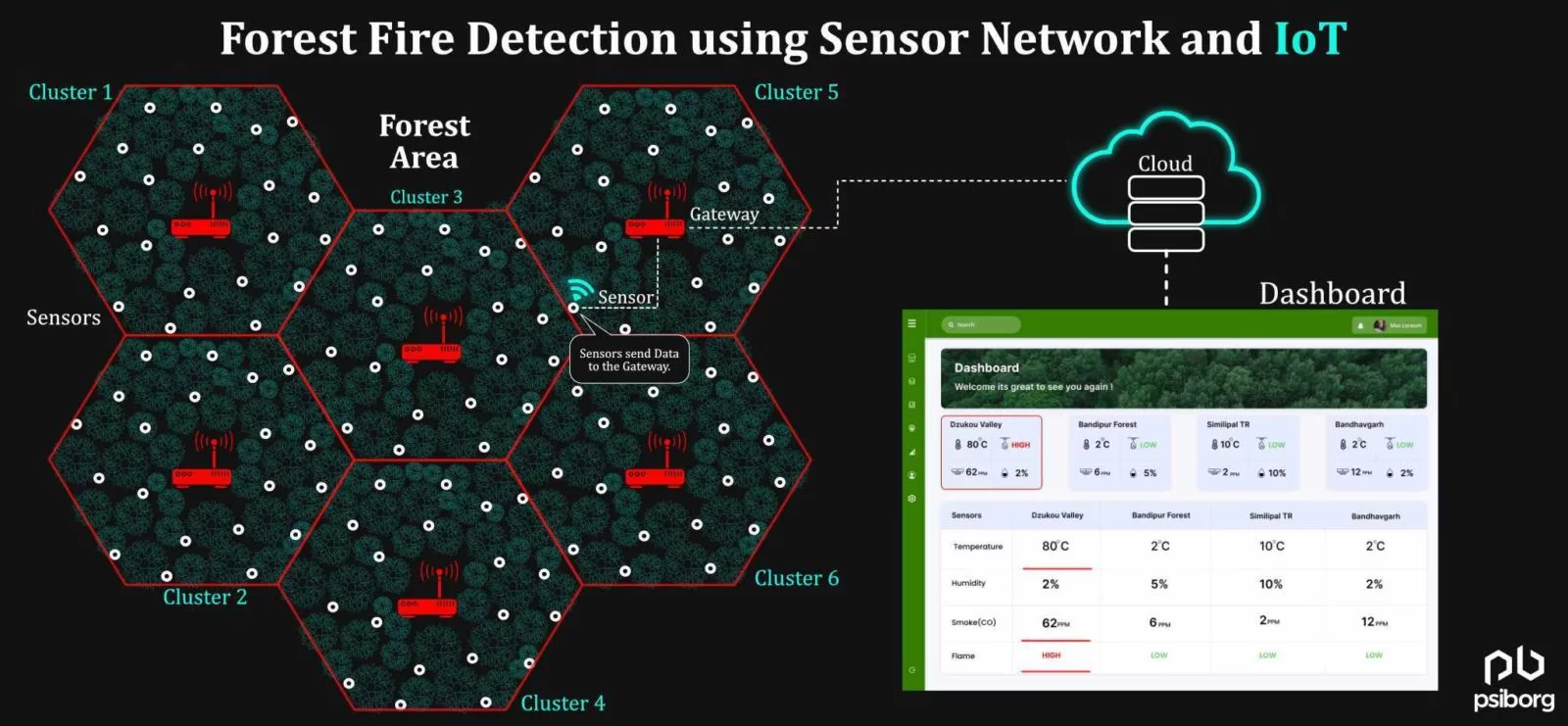Forest areas cover a large chunk of land. Often, covered with dense vegetation and most of it is inaccessible to humans. Forest Fire Detection in such a large area is a difficult task. But by using ad-hoc networks like Wireless sensor network (WSN) coupled with Internet of Things (IoT) technologies. We can effectively detect Forest Fires.
WHAT IS FOREST FIRE OR WILDFIRE?
Forest Fires take place away from urban centers but affect the environment greatly. It is a global risk that affects wildlife, humans, and climate adversely. Forests are the lungs of mother earth and support a wide variety of Flora and Fauna.
Due to increasing Human activity and Climate change the severity of Forest Fire incidents are on the rise. According to the United Nations Environment Programme (UNEP) report, the probability of Forest Fire events similar to Australia’s 2019-20 Black Summer will increase by 31-57 percent in the future. Also, according to Global Forest Watch, forest fires in India have increased by 125% between 2015 to 2017.
INSTANCES OF FOREST FIRES IN THE WORLD AND CAUSES?
According to Science Journal, approximately 20% of annual global carbon emissions are caused by forest fires. Forest Fire is a global phenomenon. Some of the fire prone Forest Areas are listed below:
- North America: California region due to high heat and dry weather conditions
- South America: Amazon basin due deliberate use for Agricultural purpose.
- Europe: Forest of France, Romania, Greece and Italy
- North Asia: Siberian region mostly in Russia due to human activity and Climate Change
- Australia: forest fires take place due to Hot Weather and lightning.
- India: Himalayan region and dry deciduous forests in India. Forests in States like Andhra pradesh, Karnataka, Madhya Pradesh and Odisha are particularly vulnerable to Forest fires. Uttarakhand forest fire of 2016 and Bandipur forest fire of 2019 are the worst recorded forest fires in India.
Broadly, Forest Fires are caused due to two reasons: Natural and Man made. Major Natural causes are Lightning, Combustion of dry vegetation, Friction between trees and Volcanic activities. On the other hand Man made causes are negligence during Campfires, Deliberate fire for agricultural practices, deforestation and electric spark. Although, according to WHO, In 50% of Forest Fires recorded, it is not known how they started

IMPORTANCE OF EARLY DETECTION OF FOREST FIRE?
According to Wikipedia, Forest fires can move as fast as 10.8 KMPH (Kilometer per hour) in forest areas and 22 KMPH in grassland.
Forest Fires depend on weather and topography. Weather conditions like Temperature, Wind, and Moisture can greatly increase the spread of forest fire. Forest Fire spreading speed increases exponentially with time. So much so that within 24 hours it can spread up to more than 3,000 acres and with each day its spreading speed increases manifold.
WHAT ARE THE DIFFERENT WAYS TO DETECT FOREST FIRES?
There are various methods to keep an eye on all forest activities. From the movement of animals to the monitoring of forest fires, there are different aspects involved in forest monitoring.
HUMAN OBSERVATION AND PATROLLING
Forest areas are spread over hundreds of acres of land which is difficult for humans to access and patrol. And forest fires are highly unpredictable which can’t be monitored by physical human and forest guards patrolling.
USING CAMERA WITH VISUAL AND INFRARED SENSORS
Optical cameras by sensing colors can detect Forest Fire. But it can’t detect fire during night. So, Thermal and / or infrared sensors are used. Sensor based cameras detect forest fires up to 15 km of range. Using a combined system also reduces the chances of false alarm as color sensing often raises false alarms. However, This method of detecting forest fires is costly and not reliable. Because the camera’s line of sight is often obstructed by canopy. Giving false position and delayed response.
UNMANNED AERIAL VEHICLES (UAV)
UAV is a small sized aircraft that can navigate without a human pilot. They are commonly known as drones. UAVs integrated with computer vision technology can effectively read images. Computer vision is a branch of Artificial Intelligence which can read and understand the visual world. UAVs fly at low altitudes and can provide aerial views of forest through images. These images are processed through Artificial intelligence techniques, to detect smoke and fire in forests.
Although this technique has many benefits but suffers from various challenges. Foremost being the regulatory framework. There are strict guidelines in various countries for operating UAVs. Since they are prone to collisions, data safety, and security. Apart from this, they can’t provide data on a real time basis and deep fires covered under the canopy can’t be detected by them.
SATELLITES
Satellites with infrared sensors can detect forest fires. Generally there are two types of satellite used for fire detection. Firstly, Geo-stationary satellites stand above the equator and have the same speed as of earth. So it remains fixed at a single location. It can detect and send images of smoke, fire and clouds every 15 minutes. Secondly, Polar orbiter satellites revolve around the poles and can produce images of possible smoke and fire once a day.
Satellite based Forest Fire detection methods suffer from operational inefficiency. As it can not detect forest fire instantaneously. Or monitor forest on a real time basis. Furthermore, Satellites are used for many other purposes. For example Remote sensing and Telecommunication. They cannot be solely made for forest fire detection.
USING INTERNET OF THINGS (IOT) FOR FOREST FIRE DETECTION
IoT is the best available, cheap and easy to scale solution for Forest Fire detection. IoT sensors are capable of accurately detecting fire related environmental variables like, carbon monoxide, smoke, temperature and relative humidity. These sensors can bear harsh forest conditions. Data from these sensors can be captured on a real time basis.
Various clusters of sensors use a Wireless sensor network (WSN) to send data to the Internet Gateway. Which in turn transfers data to the Cloud server. Cloud server performs data analysis and sends fire alerts to concerned parties instantaneously. Concerned parties like Government agencies, Firefighters and Local peoples are alerted immediately. IoT Forest Fire detection system can alert the Local people based on the level of severity of fire hazard near to them.
Also, IoT can be integrated with Drones, GPS and Satellite services. To devise an integrated Forest Fire detection system. And for preparing a Forest Fire containment and Control Action plan. Which may include preparing an evacuation plan for local people, who are near the Forest Fire area.
Cloud server data from sensors can be trained on Artificial Intelligence and Machine Learning algorithms. To build a Model using variables like Temperature and Relative humidity. This model can predict possible forest fires in future.
FOREST FIRE DETECTION USING IOT BASED SENSORS
A wireless sensor network (WSN) is a system to remotely monitor, control, communicate, and collaborate with hundreds of sensors. WSN is particularly useful for monitoring comparatively large areas, for example, Agricultural land monitoring, or LiveStock Monitoring or Measuring Environmental air pollution in any Urban Area.
Vast areas of the Forest can be easily covered with sensors. Fire in forest areas depends on the moisture content of organic matter, humidity, temperature conditions, presence of smoke etc. Heat sensors, smoke sensors, moisture sensors, and flame sensors are embedded in a Printed circuit board (PCB) with connectivity modules known as embedded devices or IoT Device hardware. The cluster of embedded sensors effectively detects forest fires.
Want to know more about WSN? Please Read: Wireless Sensor Network in IOT
WHAT ARE THE SENSORS USED TO DETECT FOREST FIRE ?
Whenever anything burns it produces Heat, Flame, and smoke. Smoke contains oxides of carbon like carbon dioxide, carbon mono-oxide (CO).
- Heat sensor: A heat sensor is a type of temperature sensing device like a thermocouple that measures surrounding temperature.
- Smoke sensor: Smoke is a latent fire. Smoke is the first sign whenever fire is there. By detecting CO we can easily detect possible fire in the Forest.
- Moisture or Relative humidity sensor: Forest fire greatly depends on wind speed and moisture content in the environment. These weather conditions can increase or decrease the intensity of forest fires. Dry weather conditions increase the probability of Forest fires. Hence monitoring this variable of great use for research studies.
- Flame Sensor: These sensors detect Ultraviolet (UV) and Infrared (IR) radiation to identify fire.
BENEFITS OF USING IOT BASED FOREST FIRE DETECTION SYSTEM
LOW COST
IoT based Forest fire detection system is comparatively less costly than other available methods. Like camera based monitoring and satellite observation.
EARLY DETECTION
IoT based systems depend on sensors which are spread in vast areas. And all of them are connected to the cloud system on a real time basis. This system offers the fastest identification of forest fires. It can pin-point the location. And alerts the concerned authorities in no time delay.
RELIABLE
The network of sensor nodes is designed in a smart way. Since the Forest, conditions are harsh. In such a scenario even if some sensors fail to work, the entire system works perfectly well.
INTEGRATABLE
Since it is an IoT based system, and uses different types of communication protocols. So it can be connected to different types of users and services through IoT web and mobile applications. Connecting to GPS and satellite systems for developing fire evacuation plans for common people stuck in forest fire regions or design a forest fire mitigation system for forest firefighters.
SUPPLEMENT IN RESEARCH AND DEVELOPMENT
Forest fire is an developing area of research as it affects climate change and global warming. So researchers want to quantify and measure forest fire causes. In other words, according to the World Wildlife Fund (WWF) 50% forest fire causes are unknown. The data gathered by sensors will also be useful for other research purposes.
WILDLIFE MONITORING
Governments and international organizations worldwide spend thousands of dollars to monitor and conserve wildlife.
Fires endanger forests because they result in enormous material and environmental damage. Preventive measures, early detection, and fire extinguishing in the initial stage are crucial in the protection of forests and wildlife. Existing systems of Forest fire detection are unreliable and inefficient. Modern smart systems based on IoT and WSN technology for Forest Fire detection systems are the need of the hour.
PsiBorg is an IoT product development company and an IoT consultant. We use state-of-the-art technology integration that provides a complete IoT based Forest Fire Detection and Monitoring system, on a case-to-case basis.
We specialize in full stack development of IoT solutions. Please go through how we develop an IoT solution.






